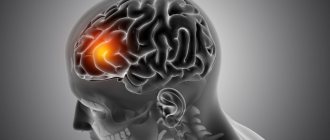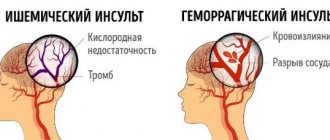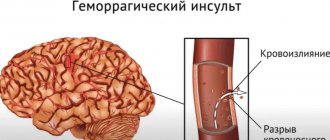Stroke is a clinical syndrome represented by general cerebral and focal neurological disorders. It develops suddenly as a result of an acute cerebrovascular accident, persists for at least 24 hours or ends in death at this or earlier time. There are ischemic and hemorrhagic strokes. Ischemic strokes occur 5 times more often than hemorrhagic strokes. In addition, so-called complex strokes (mixed strokes, hemorrhagic infarctions) are possible.
Coma during stroke mainly develops in the case of hemorrhagic stroke. Doctors at the Yusupov Hospital provide emergency care to patients admitted in a coma, using individual treatment regimens with modern drugs.
For the effective treatment of patients with stroke, the neurology clinic has all the conditions:
- modern diagnostic equipment with high resolution;
- the high scientific potential of the clinic, which employs professors and doctors of the highest category;
- effective high-class life-support equipment;
- comfortable conditions for patients’ stay and European service;
- psychological assistance to relatives and patients after recovery from a coma;
- innovative rehabilitation techniques.
All cases of patients with stroke entering a coma are discussed at the Expert Council. The decision on treatment methods is made collectively. All this together increases the chances of recovery for patients with stroke admitted in a coma to the Yusupov Hospital. Thanks to the early start of rehabilitation measures, many patients completely restore lost functions and return to normal life.
Neurologists at the Yusupov Hospital diagnose stroke in 3 stages:
- initially distinguish stroke from other conditions associated with brain damage;
- at the second stage, the nature of the stroke itself is determined - hemorrhagic or ischemic;
- in conclusion, the area of vascular damage and the pathogenesis of cerebral infarction in ischemic stroke or the localization of hemorrhage and possible mechanisms of its development in hemorrhagic stroke are clarified.
Difficulties in diagnosing a stroke arise in cases where the patient has a pronounced disorder of consciousness - coma, which does not allow conducting a survey and finding out how the disease developed. In this case, the diagnosis at the first stage is based solely on the data of the neurological examination. Of the focal neurological symptoms in a patient in a comatose state caused by a stroke, the following symptoms are often found:
- paresis of gaze or floating movements of the eyeballs;
- anisocoria (different pupil sizes in the right and left eyes)
- strabismus (squint);
- “flabby” upper eyelid;
- suppression of the corneal reflex;
- facial asymmetry;
- sail sign (“bloating” of the cheek when breathing);
- hemiparesis or hemiplegia (complete or partial impairment of the motor function of the limbs on one side of the body according to the central type).
There is no contact with a patient in a coma; the detection of a rotated foot in a patient lying on his back, decreased tone or muscle spasm in the extremities is of certain importance in the diagnosis of hemiparesis. Neurologists determine the following symptom: in a patient lying on his back, passive flexion of the head is accompanied by flexion of the lower limb in the hip and knee joints on the side of the pathological focus, and on the side of hemiplegia the leg remains in the same position.
The most difficult and responsible task of the second stage is the accurate and rapid diagnosis of the nature of the stroke, since in the acute period of the disease, further treatment tactics and the prognosis for the patient largely depend on this. After ensuring the functioning of vital organs, doctors at the Yusupov Hospital perform magnetic resonance imaging on a patient with a stroke. It is especially informative in case of hemorrhagic stroke, as it allows you to quickly determine the nature of the stroke, the location of the hemorrhage and the size of the affected area.
Why does the patient fall into a coma?
The development of coma is regarded as the result of a disease or pathological process, which is based on:
- damage to the brain stem and reticular formation;
- diffuse lesions of the cerebral cortex.
Without the support of the reticular formation, the cerebral cortex loses activity, the transmission of nerve impulses between neurons is deeply inhibited, and the coordinated activity of brain structures is lost. The brain begins to work autonomously.
The following events disrupt brain function, leading to the development of coma:
- acute cerebrovascular accidents, trauma, infections, epilepsy;
- metabolic disorders due to endocrine pathology, hormonal imbalance;
- intoxication;
- lack of oxygen and the development of hypoxia.
Working offline, the brain loses control over the body. There is a loss of consciousness and reactions to external and internal stimuli.
How to determine who
In a coma state, the patient has no mental activity and no contact with the outside world. The degree of impairment of consciousness is reliably determined using the Glasgow scale. Response to stimuli, eye opening and speech function are assessed. Reliably confirms who the score is from 4 to 8 points. During the first 24 hours, the degree of coma on the Glasgow scale serves as a prognostic sign of recovery from this state. According to statistics, 80% of patients with an initial score of 7-8 points have a chance to emerge from a coma.
Signs of coma during stroke are determined by the type of cerebrovascular lesion. With hemorrhagic stroke, coma manifests itself:
- sudden loss of consciousness;
- purplish-red complexion;
- snoring breathing;
- on the affected side the cheek is swollen;
- high blood pressure and intense pulse;
- narrowing and sluggish reaction of the pupils to light;
- decreased muscle tone;
- presence of hemiparesis or plegia.
Ischemic brain lesions are less often complicated by the development of a coma. The characteristic symptoms in this case are the following:
- gradual development of depression of consciousness;
- bright cerebral symptoms precede the development of coma;
- pale face;
- breathing may not change, sometimes tachypnea;
- the pulse is soft, arrhythmia is possible;
- An increase in tone in the paralyzed limbs is noted early.
Involvement in the process of areas of the brain in which life support centers and cranial nerve nuclei are located is often complicated by coma.
Possible causes of the attack
Hemorrhagic stroke has an acute onset. It is difficult to determine its cause, especially in the absence of a history of heart and vascular diseases. Up to 15% of cases remain unrecognized, and in a quarter of patients, hemorrhage begins without a clear cause. During the diagnosis, a rupture of the vessel is noted, and the provoking factor remains the goal of further examinations. This is necessary to prevent further relapses. In general, there are several conditions that can provoke a hemorrhagic stroke:
- chronic increase in blood pressure;
- diabetes;
- lipid metabolism disorders;
- heart and vascular diseases, including atrial fibrillation, stenosis (narrowing) of the carotid arteries, anemia;
- unhealthy lifestyle, bad habits, excess weight.
Arterial hypertension is the most common cause of hemorrhagic stroke. With a chronic increase in pressure, the strength and elasticity of the vascular walls decrease and the properties of the blood change. Patients of the Clinical Brain Institute often complain of pressure surges, but have no idea what consequences this condition can lead to. Rapid blood filling of the vessels causes their rupture with subsequent hemorrhage into the brain tissue.
Metabolic disorders also affect the condition of the vascular walls. One of the most common forms of dyslipidemia (pathologies of fat metabolism) is the accumulation of excess cholesterol. It forms deposits on the walls of the arteries, causing them to become brittle and unable to withstand stress. This condition provokes the development of atherosclerosis, a disease that is accompanied by a decrease in the elasticity of the arteries. This disease is often diagnosed as a precursor to hemorrhagic stroke.
Another pathology that can lead to spontaneous hemorrhages is diabetes mellitus. Frequent fluctuations in blood glucose levels irritate the inner lining of the walls of blood vessels, which causes their fragility. Additional factors, including surges in blood pressure, cause rupture of arteries in any area. If the process is localized in the brain area, it is dangerous with serious complications.
The lifestyle and age of the patient also affect the condition of blood vessels and the chemical composition of the blood. Only with regular physical activity is normal blood circulation possible. Sedentary work, poor diet, alcohol abuse and smoking are the main causes of increased blood viscosity, blood clots, atherosclerosis and other vascular diseases. In such conditions, strokes can occur for no apparent reason, with a slight increase in pressure.
Degrees of coma during stroke
Coma during a stroke is assessed by the depth of impairment of consciousness. The systematization is based on clinical manifestations corresponding to each stage. Separating the degrees of coma helps determine the prognosis of the disease.
Ischemic-type injuries are often characterized by the presence of precoma. Severe headache, dizziness, vomiting, paresthesia are possible. In the absence of proper attention, further depression of consciousness occurs. With hemorrhagic stroke, events develop without warning.
First degree
The first degree of depression of consciousness is called mild. The initial level of inhibition processes in the cerebral cortex is characterized by:
- complete disorientation;
- motor aphasia;
- increased muscle tone and reflexes;
- distortion of reaction to stimuli;
- constriction of the pupils, nystagmus and strabismus;
- preservation of breathing and cardiac activity;
- involuntary urination and defecation.
Second degree
Second-degree coma will manifest itself as deepening disorders reaching the brain stem. Clinical signs are as follows:
- complete lack of speech;
- tonic convulsions;
- suppression of reflexes;
- miosis, sluggish reaction to light;
- hyperthermia;
- hemodynamic instability;
- breathing disorders.
Even with adequate therapy in older people, the process may spread and develop a deep stage of coma.
Third degree
Third degree coma is considered deep. Disorders occur in the medulla oblongata. The threat to life with a cerebral hemorrhage increases. Signs of this stage are characterized by:
- loss of pain;
- loss of corneal reflexes;
- decreased muscle tone;
- dilated pupils, lack of reaction;
- shallow, arrhythmic breathing;
- decrease in hemodynamics;
- convulsive syndrome.
During the period of deep coma, tissue trophism is disrupted, which contributes to the rapid formation of bedsores.
Fourth degree
The fourth degree coma is called terminal. There are no signs of brain activity. This shows up:
- muscle atony;
- areflexia, dilated pupils;
- cessation of spontaneous breathing;
- inability to determine blood pressure.
Extensive cerebral stroke complicated by coma will have a poor prognosis.
Definition of coma
One of the common questions is the length of time a person remains in a coma after a stroke. The average duration of coma ranges from several days to two weeks, provided that emergency medical care was provided and cerebral edema was eliminated.
If there were any additional factors, then the coma state could last up to several years.
Who can predict, now we will tell you the main symptoms of the onset of coma:
- Very quiet speech, most often the person cannot connect even a couple of words.
- Specific delirium and confusion.
- The patient does not respond to external stimuli; this symptom develops quite quickly.
- Nausea or vomiting itself.
- It's hard to feel the pulse.
- The respiratory rate (respiratory rate) decreases to critical levels.
- Body temperature decreases, leading to acute heat exchange disturbances.
- There are rare cases when a patient experiences uncontrollable urination and defecation.
- Noticeable dilation of the pupils, which do not react in any way to changes in light in the environment.
All the symptoms described above develop individually, sometimes with their appearance, a person continues to do something at the level of instincts or basic reflexes. Reflexes such as breathing remain (most often, rare, shallow breathing remains, which may not be enough and the patient is connected to specialized equipment) and swallowing reflexes (thanks to which feeding with tubes can be eliminated).
It is not uncommon for convulsions, shudders, and small movements to occur during a coma.
Coma develops instantly, it is almost impossible to predict it, except for the coma that is caused by an ischemic stroke. Such serious consequences of a stroke can be noticed provided that the patient has the following symptoms:
- Severe dizziness that does not go away for a long time.
- A sharp decrease in visual acuity, complete loss of vision is possible.
- Severe and unhealthy drowsiness, the patient can fall asleep almost on the go.
- The consciousness of such patients is extremely confused.
- There is severe numbness of the extremities and a slight loss of skin sensitivity.
- Coordination of movements is severely impaired; the patient sometimes cannot stand on his feet.
Such symptoms continue for quite a long time, although people sometimes do not even pay attention to them.
Knowing these symptoms, you can contact a specialist for help in time, thereby improving the prognosis or even preventing the development of the disease.
Introduction to an artificial coma after a stroke
Massive damage during a stroke is accompanied by an increase in intracranial pressure, the development of edema and necrosis of brain tissue. Patients are put into a coma during a stroke to avoid such complications. In this case, metabolic processes slow down and cerebral blood flow decreases.
The patient is put into an artificial coma using special drugs. This is always a controlled process. The patient is returned to normal after the swelling is eliminated.
Medically induced coma has a number of consequences that negatively affect the functioning of internal organs. With further treatment, such reactions can be corrected.
Care and treatment of patients in a coma
Patients in a coma require special care. Medical supervision and care in the acute period is carried out in the intensive care unit.
The severity of the condition requires artificial ventilation and special care. Parenteral and tube nutrition. Prevention of bedsores, trophic ulcers, and the development of infection is carried out.
Treatment is aimed at ensuring the vital functions of the body. Hemodynamic parameters are monitored.
During the treatment period, the functioning of brain neurons gradually improves and is reorganized. The cells located near the affected area take on the active function.
Nutrition
The patient is provided with adequate nutrition. Feeding occurs through a tube and parenterally. In tube feeding of patients, special mixtures are used, which contain the necessary components.
It is acceptable to use baby food. Solutions for parenteral nutrition contain complexes of vitamins and microelements.
Hygiene
An immobile position and loss of sensitivity quickly lead to tissue trophic disorders and the development of bedsores. Hygiene measures are aimed at daily prevention of these violations.
For this purpose, the following is carried out:
- treatment of the oral cavity with solutions of boric acid, soda;
- treating the skin with soapy water;
- rubbing with camphor alcohol;
- changing body position in bed.
Control urination and bowel function.
Treatment
Therapeutic measures are aimed primarily at maintaining the vital functions of the body. Such measures are taken urgently and regardless of the etiology of the disease.
The patient's breathing is supported by artificial ventilation. Hemodynamic parameters are monitored. Normal levels of blood pressure and circulating blood volume are maintained. In order to correct disorders, symptomatic therapy is used using antiemetic and anticonvulsant drugs. Sedatives are prescribed.
Accurate diagnosis of stroke coma allows etiological treatment.
Surgery in the absence of contraindications increases the chances of recovery for hemorrhagic strokes. Early removal of the hematoma preserves the damaged areas to restore lost brain functions.
Coming out of a coma
When emerging from a comatose state, a gradual restoration of lost connections occurs. Cerebrovascular disorders are accompanied by the death of nerve cells. The task of the rehabilitation period is to prevent the spread of the process. This is only possible with adequate treatment.
The emergence of consciousness makes additional examinations possible for the purpose of further correction of lost skills.
Coma may emerge from a vegetative state, which indicates a poor prognosis for recovery. Only consciousness is restored, and other functions are lost. The patient can remain in this condition for a long time, death occurs from the development of infections and bedsores.
What the awakening will be like depends on the type of violation, the degree of damage, and adequate treatment.
Mechanism of occurrence and types of hemorrhagic stroke
A stroke is an acute cessation of blood supply to tissues. This condition leads to necrosis of nerve cells, which are slowly restored and cannot perform their usual functions. The most common type is ischemic stroke - neurons are deprived of oxygen due to blockage of arteries and other vascular pathologies. Hemorrhagic stroke is more life-threatening and is associated with vascular rupture and subsequent hemorrhage. Its severity depends on the location of the damaged area, the caliber of the vessel and other factors, including the age of the patient.
Hemorrhagic strokes are usually classified according to the place of their occurrence. So, there are several main varieties:
- parenchymal - occurs directly in nerve tissues;
- intraventricular - hemorrhage into the cavity of the ventricles of the brain;
- subdural - blood enters under the dura mater of the brain;
- epidural - the focus is localized above the hard shell;
- subarachnoid - hemorrhage between the arachnoid and pia mater of the brain.
When blood enters nerve tissue or the cavity of the brain, hematomas of various sizes are formed. Their appearance causes tissue swelling, which puts pressure on neurons. If there is no blood supply, they die. As a result of necrosis of nerve cells, there is a loss of vital skills, a sharp deterioration in health, and the risk of developing coma remains. In addition, the acute period is dangerous and fatal, and during the rehabilitation process a recurrence of stroke is possible.
Recommendations for relatives of patients
Patients require increased attention when emerging from a comatose state. The help and support of relatives during this period is of great importance. It has been proven that the period of functional restoration with the support of relatives is significantly reduced and gives positive dynamics. The risk of repeated cerebral accidents increases with the development of diabetes, lipid disorders, and hypertension.
You can avoid a recurrent stroke and irreparable consequences by doing the following:
- creating a favorable environment;
- motivation to conduct daily classes to restore speech and motor skills;
- obligatory praise for achieved results;
- mastering simple massage skills;
- proper care and nutrition;
- control of blood sugar, cholesterol;
- instilling hope for recovery.
These measures, together with complex therapy, give positive results.
Consequences
If patients can be saved, they experience neurological deficits—symptoms caused by damage to the area of the brain where the hemorrhage occurred.
These may be consequences of a hemorrhagic stroke:
- paresis and paralysis - impaired movement of the limbs on one half of the body, since they are constantly in a half-bent position and it is impossible to straighten them;
- speech impairment and its complete absence;
- mental disorders and irritability;
- constant headaches;
- movement coordination disorders;
- inability to walk or even sit independently;
- visual impairment up to complete blindness;
- facial distortion;
- vegetative state - the absence of any signs of brain activity (consciousness, memory, speech, movements) with preserved breathing and heartbeat.
Symptoms of the disease and their duration depend on the location of the hemorrhage and its volume. The first 3 days are the most dangerous, since during this time severe disorders occur in the brain. Most deaths (80–90%) occur during this period. The remaining 10–20% of patients die within one to two weeks. Patients who survive recover gradually from a few weeks to 9–10 months.
What could be the outcome
Extensive cerebral hemorrhages with the development of coma leave behind consequences, which are presented in the following form:
- recovery from a coma with partial restoration of lost functions;
- exit without restoration of nervous system functions;
- transition to a vegetative state;
- the onset of brain death.
Often, persistent cognitive impairment remains at the end of treatment. Speech is not fully restored, and attention and memory impairments persist.
Major strokes accompanied by coma leave little chance of survival. Such conditions cannot be avoided without the preservation of paralysis and motor impairment. Characterized by frequent mood swings and personality changes.
The consequences of emerging from a coma after a stroke can be complications in the functioning of internal organs and systems. Complications after a long stay in a coma are manifested by pneumonia, cystitis, vascular disorders, and the development of muscle atrophy.
Brain death occurs as a result of hypoxia. Manifested by a lack of breathing, cardiac activity, and consciousness. Life is supported by hardware.
Features of recovery from unconsciousness
A distinctive feature is the return of an adequate state in the opposite manner of oppression. With positive dynamics, muscle and skin reflexes appear. The patient begins to swallow and respond to pain. The return of consciousness is combined with episodes of delirium and hallucinations. Speech, memory, coordinated movements require long-term rehabilitation.
How to bring a person out of a coma
It’s worth starting with the fact that even from a severe coma, about 9-10% of patients return. At the same time, many continue to live in a normal state, without turning into a “vegetable”. In such patients, lost brain functions are restored, but this process can take quite a long time. It all depends on the degree of damage to the brain cells.
Coming out of a coma looks like this:
- The ability to swallow returns, muscles and skin begin to respond to irritants. The motor reflex is restored, the patient can turn his head.
- Consciousness returns slowly, but the patient begins to experience hallucinations. You should not be afraid of this - in this case it is a sign of positive dynamics. Speech, memory and vision are partially restored.
- The patient tries to move, sit independently, then begins to stand up and move around with support.
As soon as the patient regains consciousness, he undergoes a tomography to diagnose the extent of brain damage and select restorative therapy.
The rehabilitation process requires a lot of strength, both physical and moral, and not only from the patient - the most important role in his fate is played by close people. The main goal of rehabilitation is to prevent destruction of other parts of the brain. To do this, you will have to work out a lot and for a long time, performing a set of special exercises.
The task of relatives is to help the victim recover from the experience and create favorable conditions for the restoration of his normal functioning. To reduce the likelihood of a recurrent stroke, relatives need to follow some recommendations:
- Praise the patient even for small progress.
- Give hope for a full recovery.
- Create a homely environment and a favorable psychological climate around you.
- Learn how to massage and help the patient restore body functions.
Love and care work wonders. Pay more attention to the patient, this will help him recover faster.








